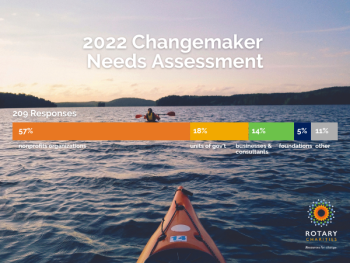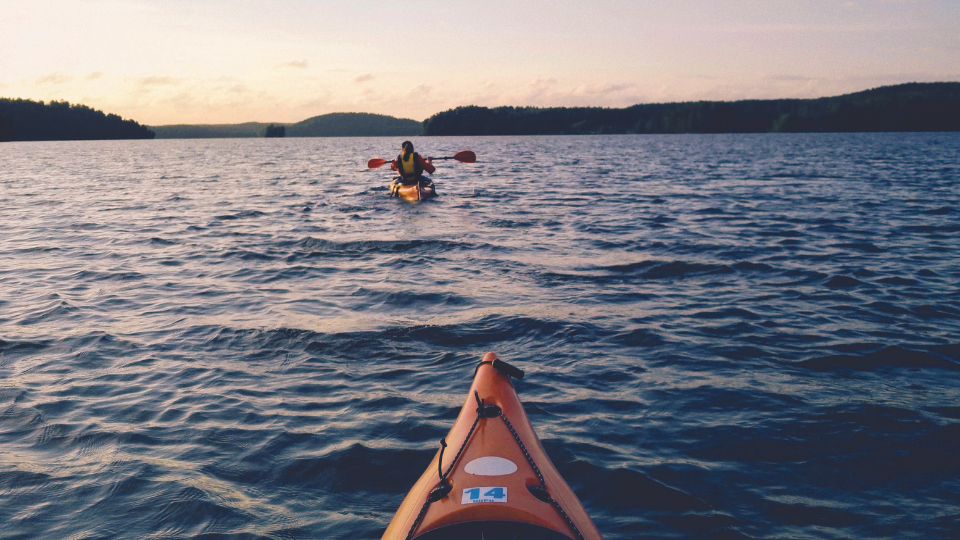What, So What, Now What

In 2022-23, Rotary Charities is experimenting with working more “out loud” by sharing some of our tools and processes, questions we’re asking ourselves, and our work in progress. In this blog, our Director of Systems Change & Learning, Freya Bradford, first shares some of the results of our Changemaker Needs Assessment and then explores a process we are trying to apply learnings like those and the questions it is bringing up for her.
Rotary Charities completed a Changemaker Needs Assessment in early 2022 to better understand how individuals and organizations were faring, the challenges they faced, and how we might better support changemaking work in the region. We received 209 responses from changemakers all over our service area representing nonprofit organizations, units of government, businesses, foundations, and more.
The Changemaker Survey is a key source of vital information that we use to adapt our work to better meet the needs of the region. Several key patterns emerged from the data.
Nonprofit organizations are experiencing significant human resource challenges. Respondents report an increase in burnout (52%), difficulty recruiting staff (47%), and a decrease in volunteers (40%). This is in the face of increasing demand, a trend 90% of respondents predict will continue in the next year. Despite these challenges, most organizations increased programming or improved or adapted existing programs. Other adaptations were made to adapt to COVID-19 and improve employee satisfaction like flexible scheduling and work environments (67%), adjusted pay scales and workload expectations (36%), or new benefits (28%).
Organizations are increasing their focus on diversity, equity, and inclusion (DEI). The large majority of respondents indicated that their organization had increased their focus on DEI in the last two years (69%), many of them with outside help. Changes resulting from the work varied from increased learning; changes to mission, vision, or goals; changes to programs or services; or operations changes to things like hiring or board composition. Despite this progress, many reported barriers to engaging more deeply, including a lack of board support, a lack of funding for assistance, or not knowing where to start.
Networks and coalitions are a popular way to organize work around community goals in the region, but many challenges persist. More than three-quarters of respondents (76%) reported participating in at least one network or coalition working together on a common goal. The majority report wanting to do more collaborative work to change the upstream causes of complex problems (systems change work). However, many barriers to this type of work persist, including a lack of funding, turfism or competition for resources, and a lack of accountability for the additional work created by the collaborative.
A full report can be found here.
Moving from Insight to Action
Data like this from the Changemaker Needs Assessment is a critical input for Rotary Charities. We’ve long used data to inform our approach, but over the last few years, we have been more intentional about trying to adapt more rapidly.
Lately, we have been using a simple process called What, So What, Now What when we have new insights from things like surveys or After Action Reviews. The process helps create a bridge between insight and action. I was first introduced to this Liberating Structure through the Human Systems Dynamics Institute.
The tool asks three primary questions that we record in three columns.
| What | So What? | Now What? |
|---|---|---|
What insights stood out from the data? | Why is that important? | What might we do/try to shift to a different (healthier/more desirable) pattern? |
We use What, So What, Now What (W3) as a team, usually filling in the “What” column completely first and then asking “So What” and “Now What” of each insight. If you have a lot of insights at one time, like we did for the Changemaker Survey, it can be helpful to group insights into themes first.
The following is an example from our W3 for the Changemaker Needs Assessment.
| What | So What? | Now What? |
|---|---|---|
| The majority of NPO leaders have been in their current position for 5 years or less. |
|
|
To move from the columns to action, we added a prioritization and tracking process.
A “What,” or insight or group of insights, rises to the top of our to-do list when it:
- Has a compelling “So What:” A pattern is suggested that is confirmed by other data. And/or there may be some urgency to try to intervene because the potential for impact is large or it is an opportune time to make a difference.
- Has a clear “Now What:” We have an idea of a change we can make to a practice or approach that is within our control and aligned with our mission, vision, budget, and timeline. Sometimes the “Now What” suggests significant changes to strategy or policy – we bump those questions up to the board.
In the example above, we prioritized learning opportunities around succession planning by offering an upcoming workshop, “Managing Leadership Transitions & Building Your Organization for the Future.” We’re also exploring the idea of convening a peer learning circle for executive directors. Both of these ideas had complementary data in other parts of the survey and were aligned with our mission and budget.
We have started moving prioritized “Now Whats” to a kanban board we call Adaptations in our project management app Asana. Each prioritized adaptation gets a card and is put in a column called “Ideas for Adaptation.”Each card includes the source insights (the What and So What) so we don’t lose our original inspiration. To move from the “Ideas” column to “Adaptations in Action,” the idea needs a staff champion. Once assigned, the card becomes a task that the staff member will manage with their other project tasks in Asana. When the adaptation is complete, the card gets moved to the “Adaptations Complete” column. In this way, we will have a record of all the changes we’ve made and why, making our guiding principle of adaptation more visible and manageable.
Managing our adaptations like this is still very new, and we will surely learn much as we go. For now, the questions that have been coming up for me as we accelerate this ability to adapt:
- Is there an optimal balance between time spent learning and adapting and time spent doing and delivering? What is too much change? And what might signal it?
- Is the time of “best practices” over? In other words, are we post the time where someone finds out what works and then just repeats and scales it? Or are the new “best practices” the replication and scaling of the learning practices that allow us to adapt anything to changing conditions and contexts?
- How do we remain mindful of different tolerances for rapid change, group reflection processes, and tracking?
How does this resonate with you? Do you have a process for turning new ideas into actions? I’d love to hear from you!
Freya Bradford is Rotary Charities Director of Systems Change & Learning. She can be reached at fbradford@rotarycharities.org.



